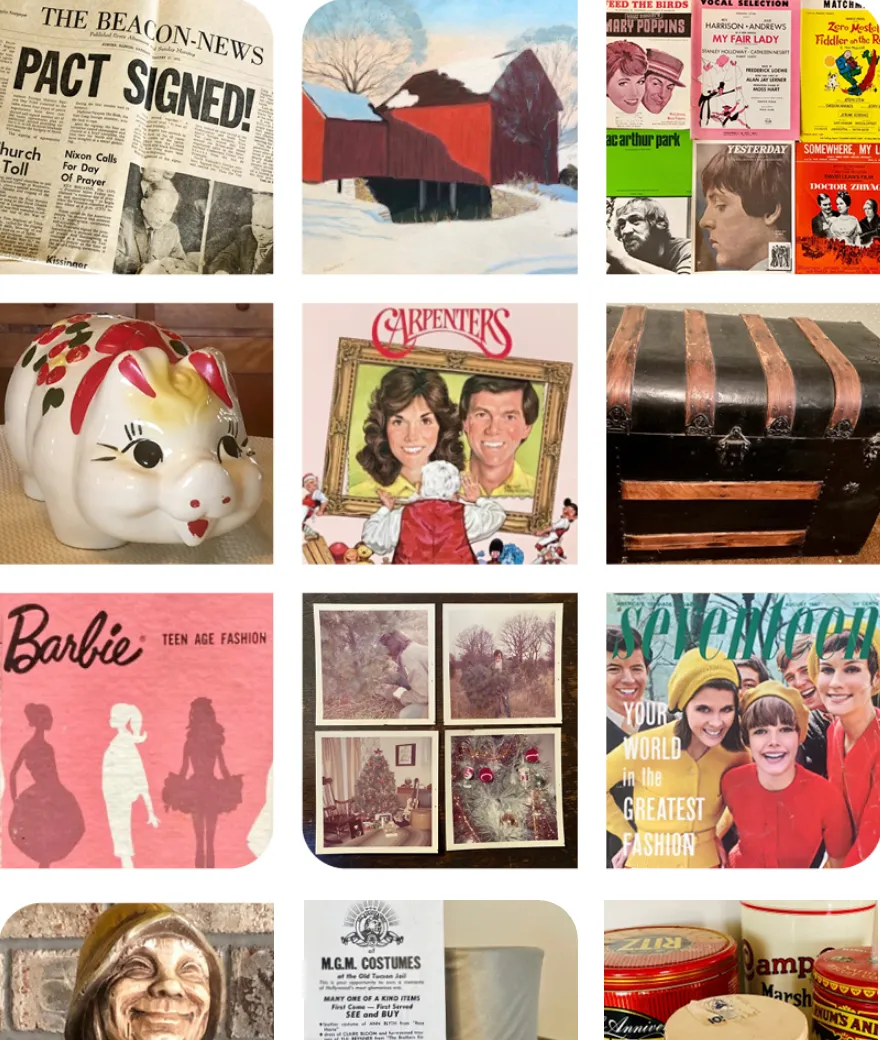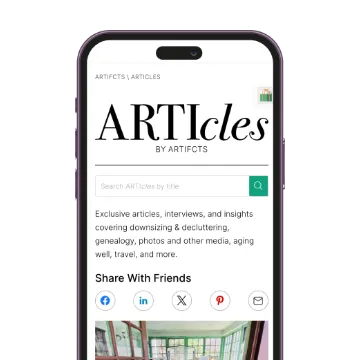When I moved three times in as many years, I had no choice but to come to terms with what stuff I owned and whether it warranted a spot in a moving box, place on the truck, and space in my next home. Of course, in a pinch, and if space was not at a premium, I knew which boxes left unopened for multiple moves I could contentedly continue to ignore for another day and hand into the truck.
But that level of awareness is unique I think to people who move a lot. A professional home organizer told me recently that her clients get tripped up when decluttering and organizing a space because they have forgotten what was even in it. So, they rediscover items they already own and want to keep them and put them to use. There’s a human psychological phenomenon in play here. Namely, we tend to place greater value on items we already own.
Clients get tripped up when decluttering and organizing a space because they have forgotten what was even in it. - Home Organizer, Austin, Texas
Through Artifcts, my co-founder and I have spent an above average amount of time with people who are moving and/or downsizing as well as the professionals who assist them. Along the way, we have picked up on some tricks to help us with our own 'stuff’ of daily life and are eager to share them here with you to help reduce your day-to-day stress and enjoy your homes more.
____________________
The Obvious Strategy: Pretend You’re Moving
Before we cover any true tips and life hacks, let’s just put it out there: Even if you have no intent on moving anytime soon, pretending you are and going zone by zone through your home can be an incredibly effective decluttering technique.
Few of us follow golden rules popularized by the likes of Martha Stewart when it comes to regularly refreshing all of our spaces, including those cabinets and closets, to remove dust and other debris. When you tackle one zone after another this strategy becomes a decluttering and home cleaning win all in one!
The Second Most Obvious: You Don’t Need It, but Someone Does
Decorative pillowcases, picture frames, books, and special glasses and dessert plates are great examples of this downsizing theme. Yes, it is perfectly good. Yes, it’s perfectly usable. But you have outgrown it. That’s okay! Tastes and preferences change. Your space has changed. You simply don’t need it. That’s life. You married your spouse, not the ‘stuff,’ so give yourself some grace and the permission to let it go. It's natural to let go of stuff.
How exactly should you go about letting go?
For some, the answer to this type of ‘stuff’ is charity. Temporary homes for abused persons and other displaced individuals often need the sort of TLC cozy and practical home goods and décor can offer. Donate locally! Or check our free Going Green guides for ideas.
For others, taking a page out of Margareta Magnusson’s book, The Gentle Art of Swedish Death Cleaning, is just the ticket. And no, you don’t have to be dying or in your senior years to use this concept in your life. When it comes to ‘stuff,’ Magnusson reminds us that rehoming items not only lets us share the stories and value of them with loved ones now, but it helps us to live as comfortably and stress-free as possible without the burden stuff can become.
Shred and Digitize, Today not Tomorrow.
Accidentally accumulating paperwork—yes, including photos—to sort through another day? Do not take a shortcut and stick it all in a binder or bin. That's a Band-Aid. Let’s go for a sustainable and useful fix. Mass digitizing and shredding can immediately clear spaces in your home and the back of your mind from this sort of clutter.
Yes, it could mean you now have shifted it to digital clutter, but at least you freed up space and now that it’s digitized, it’s accessible when you are on the go, shareable and searchable, and protected from destruction by mother nature or theft. You can’t say that for a filing bin, cardboard box, or cabinet.
And your files are ready to upload into whatever app you are using for planning all of life’s nexts. Perhaps those cards, postcards, letters, photos, and pieces of kid art are ready for Artifcting along with their stories. Maybe you need to add that latest home insurance policy into your digital vault, like Trustworthy.
Done digitizing? Now recycle.
Piles with Timelines (#IveBeenMeaningTo)
When you are heading toward a move, you start clustering things naturally in your mind: making the move, heading to donation, must ask a friend/family member if they want it, selling this, etc. If you apply that logic on a daily life basis, and dedicate a strategy for each intent, you’ll have a great habit that keeps you decluttering regularly.
Perhaps you have an under-the-bed bin, a cute basket with a lid, or even a simple bag tucked into a closet where you can put anything you’re ready to donate.
Perhaps you Artifct sentimental and valuable items and set a reminder with the Artifcts “In the Future” feature to sell by a certain date. Or maybe instead you share that Artifct with a loved one to see if they want it (especially now that they know the story) before you sell, donate, or otherwise rehome it. The act of asking not only avoids traps that faulty assumptions might set, but it’s also a best practice in managing your family history estate.
Another reason those move piles work wonders? It’s visible progress. For the items that have already made it through your assessment and are keepers, we strongly encourage adding a QR code so that you (and everyone else who looks) can see this item matters and can scan to learn why.
(Re)Set Up Your Home for Convenience and Peace
One of the best parts of a move is setting up your home again. You have a blank slate. Nothing is stopping you from using this blank-slate strategy even if you are not moving:
-
-
- Grab a pen and paper or open up a blank note on your phone.
- Go room by room.
- Do you see any pain points, constantly cluttered areas, things that are broken or damaged? Note it all down.
- Review and prioritize for action.
-
Let’s walk through some examples.
Is it constantly irritating and slightly absurd that your hook for your reusable shopping bags is in the pantry and nowhere near the car you get into to go shopping? Move the hook.
How about the fact that naturally everyone in your home has some volume of clutter. And it’s everywhere, including on the counter, on the table, on the coffee table. I have a specific pen I love, a tape measurer, a set of Artifcts QR code stickers, and a book I’m reading, all of which I want readily accessible. Create a home for your clutter. I have a cute little pop-up crate on my bookshelf that holds these and other random items. Problem solved. (And, yes, my husband and daughter have crates, too.) And our family also has a small crate for common household stuff like scissors, tape, batteries, and a retractable utility knife.

Furniture falls into this category, too, albeit we’re not always in the right place financially to do anything about it. But if you are, everyone who moves knows that you do not want to ship furniture that you always found uncomfortable, has a worn-out look that is not intentional or repairable, or is literally outgrown, like a toddler sized rocking chair. Sell or donate it, but either way, move it on out!
Schedule it.
When you’re on deadline, as in the moving trucks will arrive one month from today, you have no choice but to get stuff done. Many people already keep things running on a schedule at home anyway, e.g. how often the chimney is inspected, the air filters replaced, or the windows washed. Why wouldn’t you add decluttering to your schedule? Home is not just where you spend the majority of your time, but it is also a place that should help you to feel recharged and comfortable.
If daily or weekly sounds too intense, try monthly, as in, the third Sunday each month you schedule a specific space in your home for a once over. Sometimes it might be a “simple” drawer, other times you might schedule the front hall closet, because it’s a month when you know you’ll have more time. You do not need to make it a stretch goal. You just need to make the decluttering a reality.
And if you are truly under deadline, perhaps a guest is coming to stay, or you just feel overwhelmed, consider hiring a professional organizer to get you started with the most challenging spot for you.
____________________
All of these strategies are about (re)organizing and removing things that drain your energy and provoke frustration so you can live your life more smoothly. We hope you test them out, revise to your liking, and reap the rewards.
Looking for still more ideas? Check out the article, 16 Expert-Approved Organization Hacks to Simplify Your Next Move, from MovingPlace. The article features quick, actionable tips from cross-industry experts, including organizational psychologists, best selling authors on organizing and decluttering, and more!
Happy Artifcting!
###
You may also be interested in these ARTIcles related to decluttering and downsizing:
#HabitChange: Rescue and Preserve Those Memories
15 Years In Storage: Now What? Tips Before & After You Store 'Stuff'
Sorry, Not Sorry: I Love My Stuff
© 2025 Artifcts, Inc. All Rights Reserved.












 Artifcts member @CJH Artifcted their Super Bowl ring along with photos from the big game.
Artifcts member @CJH Artifcted their Super Bowl ring along with photos from the big game.
 A treasured family Artifct complete with video! Sorry, it's private.
A treasured family Artifct complete with video! Sorry, it's private. 








 Click the icon to listen to Heather's daughter describe her Artifcting experience.
Click the icon to listen to Heather's daughter describe her Artifcting experience. 




